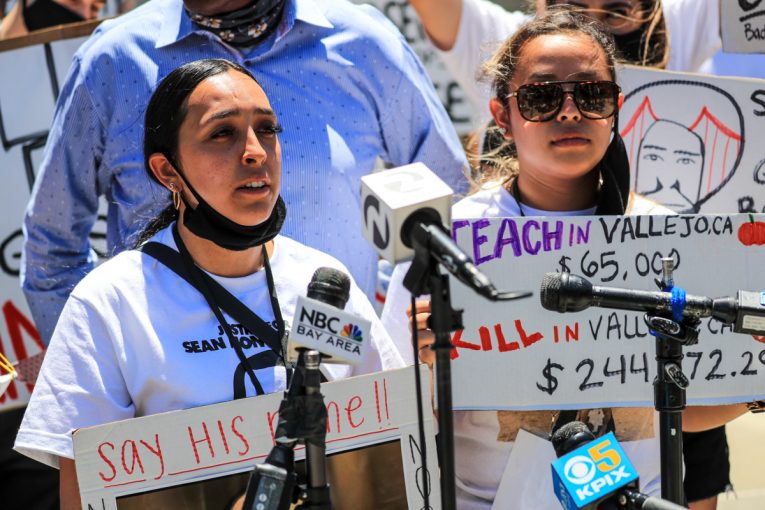

By David M. Greenwald
Executive Editor
Vallejo, CA – A report from June 2021 was released late on Thursday last week faulting the handling of the shooting by Vallejo Police.
The report conducted by the OIR Group led by Michael Gennaco and Stephen Connolly found that the involved officers used “unreasonable force.”
The incident occurred on June 2, 2020, when Vallejo police, responding to reports of looting at a Walgreens location in Vallejo, saw Sean Monterrosa in the parking lot and mistook a hammer for a gun, and the officer fired five rapid rounds at Monterrosa. Monterrosa would die from his injuries.
When officers approached, Monterrosa “turned in the direction of the officers and went into a kneeling position.”
One of the officers following the shooting said, “What did he point at us?
Another responded, “I don’t know, man.”
The third said, “Hey, he pointed a gun at us.”
According to the report, “VPD policy establishes that when evaluating whether an officer has used reasonable force, a number of factors should be taken into consideration. A consideration of those factors shows that (redacted) use of  force was not objectively reasonable.”
force was not objectively reasonable.”
Citing from Penal Code section 835(a), the investigations note that reasonableness is “judged from the perspective of a reasonable officer on the scene at the time” and recognizes that “officers are often forced to make split-second decisions.”
The officer who fired the rounds stated that his reason for shooting Monterrosa “was his belief that Monterrosa was armed and was reaching for a firearm to him him or his partner officers.”
However, Monterrosa did not have a firearm.
“That does not end the inquiry,” however, because the question is whether “the mistaken perception” of the threat was “objectively reasonable.”
The report notes that at times it might have been, but here “it was the detectives that closed distance and increased their risk, at the same time decreasing their tactical options.”
Such an approach, they write, “increased the likelihood that actions consistent with surrendering could also be interpreted as acts of aggression and lead to the resulting application of unreasonable force.”
They add that “it was premised in large part on the manner in which the detectives’ approach left no margin for error, thereby subjecting Mr. Monterrosa to an unduly extreme interpretation of a movement that was ambiguous or even meant as surrender, as discussed immediately below.”
Monterrosa was located with a group of individuals believed to have been involved in a burglary of a commercial establishment and was perhaps armed with a gun, the report notes.
However, the report notes that the police acknowledged “these indicia of threat should have been heeded as a reason not to approach without a plan; the officers’ reckless approach was the most significant factor in increasing the level of threat presented to them.”
The police acknowledged that, after being spotted, Monterrosa “abruptly changed course” and then “crouched onto one or both knees while facing the officers.”
They described this as an “aggressive posture” and a “shooting stance” that “raised their threat perception.”
But, as the report notes, “this interpretation proved to be objectively incorrect insofar as Mr. Monterrosa had nothing to shoot with.”
Importantly, they say, “it is further challenged by the extent to which the same conduct by Mr. Monterrosa was also potentially consistent with an intent to surrender – a theory reinforced by the reality that he did not in fact have a gun.”
Moreover, “the fatal shot to Mr. Monterrosa entered the back of his head, inconsistent with the officers’ statements that he was facing them in an aggressive shooting stance at the time (redacted) shot him.”
The report faults the officers for violations of de-escalation and unsatisfactory work performance policies.
According to the Vallejo Police de-escalation policy, it requires, when it is reasonably safe, prudent and feasible to do so, an officer shall attempt to “slow down, reduce the intensity or stabilize the situation through de-escalation so that more time, options and/or resources may become immediately available for incident resolution.”
Moreover, an express factor to consider in evaluating the reasonableness of any use of force is: “the availability of other reasonable and feasible options and their possible effectiveness.”
The officers here “failed to effectively deploy the de-escalation techniques set out in VPD policy.”
The mistakes by the officers “left the three detectives with insufficient time to evaluate the complex situation they were confronting and properly assess risk, and they did not take the initiative to ameliorate this problematic circumstance.”
The report adds that “there was no indication that engaging in such force de-escalation members as set out in the policy would have jeopardized the safety of the community or of any employee. There were no indicia that the behavior of the individuals outside the Walgreens presented imminent jeopardy to the Vallejo community.”
The officers were also faulted for a delayed activation of body-worn cameras—with each officer acknowledging they “activated his own body-worn camera at a point after the shooting had already occurred. ‘The buffering feature of the cameras did provide video that encompassed several seconds prior to the use of deadly force, but there was no audio accompanying this
portion of the recordings.”


This one always smelled wrong; I’m not surprised by the finding.
Are we supposed to know who the OIR Group is? From the wording, it appears that the group is “led by” attorneys. If so, who do those attorneys represent?
Here’s some information regarding the OIR Group.
https://www.oirgroup.com/
In this case, did the city of Vallejo hire them?
For those who didn’t know, Gennaco is Davis’ Independent Police Auditor (not mentioned in the article since this wasn’t a Davis article) – https://www.cityofdavis.org/Home/Components/News/News/3054/